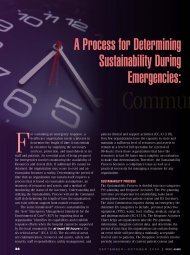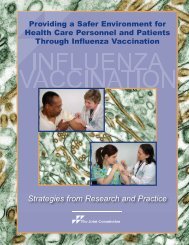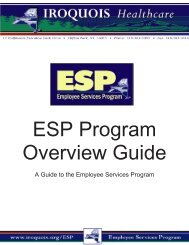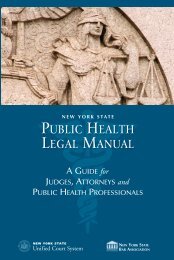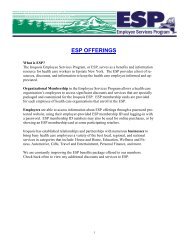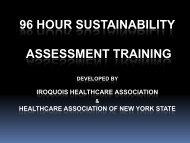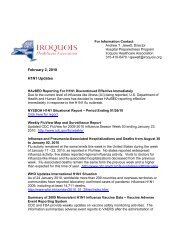CMS Memo: EMTALA Requirements & Options for Hospitals in ...
CMS Memo: EMTALA Requirements & Options for Hospitals in ...
CMS Memo: EMTALA Requirements & Options for Hospitals in ...
Create successful ePaper yourself
Turn your PDF publications into a flip-book with our unique Google optimized e-Paper software.
DEPARTMENT OF HEALTH & HUMAN SERVICES<br />
Centers <strong>for</strong> Medicare & Medicaid Service<br />
7500 Security Boulevard, Mail Stop S2-12-25<br />
Baltimore, Maryland 21244-1850<br />
Center <strong>for</strong> Medicaid and State Operations/Survey and Certification Group<br />
Ref: S&C-09-52<br />
DATE: August 14, 2009<br />
TO:<br />
FROM:<br />
SUBJECT:<br />
State Survey Agency Directors<br />
Director<br />
Survey and Certification Group<br />
Emergency Medical Treatment and Labor Act (<strong>EMTALA</strong>) <strong>Requirements</strong> and<br />
<strong>Options</strong> <strong>for</strong> <strong>Hospitals</strong> <strong>in</strong> a Disaster<br />
<strong>Memo</strong>randum Summary<br />
• Plann<strong>in</strong>g <strong>for</strong> Surge <strong>in</strong> Emergency Department Services: A brief summary of <strong>EMTALA</strong><br />
requirements and options <strong>for</strong> hospitals experienc<strong>in</strong>g an extraord<strong>in</strong>ary surge <strong>in</strong> demand <strong>for</strong> ED<br />
services has been developed to assist hospitals and their communities <strong>in</strong> plann<strong>in</strong>g <strong>for</strong> a<br />
potential surge <strong>in</strong> ED volume this fall related to H1N1 <strong>in</strong>fluenza.<br />
• Waiver Description: Rules govern<strong>in</strong>g <strong>EMTALA</strong> waivers are also described.<br />
• Availability and Distribution of Summary Sheet: State Survey Agencies (SAs) are<br />
requested to distribute this summary sheet widely to hospital and emergency response<br />
plann<strong>in</strong>g officials.<br />
In anticipation of a possible significant <strong>in</strong>crease <strong>in</strong> demand <strong>for</strong> emergency services due to H1N1<br />
<strong>in</strong>fluenza resurgence this fall several Federal agencies, State health departments, and hospitals<br />
have expressed significant concerns about compliance with <strong>EMTALA</strong> requirements dur<strong>in</strong>g an<br />
outbreak. Many stakeholders perceive that <strong>EMTALA</strong> imposes significant restrictions on<br />
hospitals’ ability to provide adequate care when EDs experience extraord<strong>in</strong>ary surges <strong>in</strong> demand.<br />
The attached fact sheet clarifies options that are permissible under <strong>EMTALA</strong> and should<br />
reassure the provider community and public health officials that there is exist<strong>in</strong>g flexibility under<br />
<strong>EMTALA</strong>. Among other th<strong>in</strong>gs, the fact sheet notes that an <strong>EMTALA</strong>-mandated medical<br />
screen<strong>in</strong>g exam<strong>in</strong>ation (MSE) does not need to be an extensive work-up <strong>in</strong> every case, and that<br />
the MSE may take place outside the ED, at other sites on the hospital’s campus.<br />
The fact sheet also summarizes the provisions govern<strong>in</strong>g <strong>EMTALA</strong> waivers. Surveyors and<br />
managers responsible <strong>for</strong> <strong>EMTALA</strong> en<strong>for</strong>cement are expected to be aware of the flexibilities<br />
hospitals are currently af<strong>for</strong>ded under <strong>EMTALA</strong> and to assess <strong>in</strong>com<strong>in</strong>g <strong>EMTALA</strong> compla<strong>in</strong>ts<br />
accord<strong>in</strong>gly <strong>in</strong> determ<strong>in</strong><strong>in</strong>g whether an on-site <strong>in</strong>vestigation is required. They are also expected<br />
to keep these flexibilities <strong>in</strong> m<strong>in</strong>d when assess<strong>in</strong>g hospital compliance with <strong>EMTALA</strong> dur<strong>in</strong>g a<br />
survey.
Page 2 – State Survey Agency Directors<br />
To help dispel misconceptions among the provider community concern<strong>in</strong>g <strong>EMTALA</strong><br />
requirements, SAs are requested to distribute the attached fact sheet widely to the provider<br />
community <strong>in</strong> their State, as well as to State and local public health officials responsible <strong>for</strong><br />
emergency preparedness.<br />
Questions about this document should be addressed to CDR Frances Jensen, M.D., at<br />
frances.jensen@cms.hhs.gov.<br />
Tra<strong>in</strong><strong>in</strong>g: The <strong>in</strong><strong>for</strong>mation conta<strong>in</strong>ed <strong>in</strong> this letter should be shared with all survey and<br />
certification staff, their managers, and the State/RO tra<strong>in</strong><strong>in</strong>g coord<strong>in</strong>ators immediately<br />
/s/<br />
Thomas E. Hamilton<br />
cc: Survey and Certification Regional Office Management<br />
Attachment
DEPARTMENT OF HEALTH & HUMAN SERVICES<br />
Centers <strong>for</strong> Medicare & Medicaid Service<br />
7500 Security Boulevard, Mail Stop S2-12-25<br />
Baltimore, Maryland 21244-1850<br />
FACT SHEET<br />
Emergency Medical Treatment and Labor Act (<strong>EMTALA</strong>) &<br />
Surges <strong>in</strong> Demand <strong>for</strong> Emergency Department (ED) Services Dur<strong>in</strong>g a Pandemic<br />
I. What is <strong>EMTALA</strong>?<br />
• <strong>EMTALA</strong> is a Federal law that requires all Medicare-participat<strong>in</strong>g hospitals with dedicated<br />
EDs to per<strong>for</strong>m the follow<strong>in</strong>g <strong>for</strong> all <strong>in</strong>dividuals who come to their EDs, regardless of their<br />
ability to pay:<br />
- An appropriate medical screen<strong>in</strong>g exam (MSE) to determ<strong>in</strong>e if the <strong>in</strong>dividual has an<br />
Emergency Medical Condition (EMC). If there is no EMC, the hospital’s <strong>EMTALA</strong><br />
obligations end.<br />
- If there is an EMC, the hospital must:<br />
+ Treat and stabilize the EMC with<strong>in</strong> its capability (<strong>in</strong>clud<strong>in</strong>g <strong>in</strong>patient admission when<br />
necessary); OR<br />
+ Transfer the <strong>in</strong>dividual to a hospital that has the capability and capacity to stabilize the<br />
EMC.<br />
• <strong>Hospitals</strong> with specialized capabilities (with or without an ED) may not refuse an appropriate<br />
transfer under <strong>EMTALA</strong> if they have the capacity to treat the transferred <strong>in</strong>dividual.<br />
• <strong>EMTALA</strong> ensures access to hospital emergency services; it need not be a barrier to provid<strong>in</strong>g<br />
care <strong>in</strong> a disaster.<br />
II.<br />
<strong>Options</strong> <strong>for</strong> Manag<strong>in</strong>g Extraord<strong>in</strong>ary ED Surges Under Exist<strong>in</strong>g <strong>EMTALA</strong><br />
<strong>Requirements</strong> (No Waiver Required)<br />
A. <strong>Hospitals</strong> may set up alternative screen<strong>in</strong>g sites on campus<br />
• The MSE does not have to take place <strong>in</strong> the ED. A hospital may set up alternative sites<br />
on its campus to per<strong>for</strong>m MSEs.<br />
- Individuals may be redirected to these sites after be<strong>in</strong>g logged <strong>in</strong>. The redirection<br />
and logg<strong>in</strong>g can even take place outside the entrance to the ED.<br />
- The person do<strong>in</strong>g the direct<strong>in</strong>g should be qualified (e.g., an RN) to recognize<br />
<strong>in</strong>dividuals who are obviously <strong>in</strong> need of immediate treatment <strong>in</strong> the ED.<br />
• The content of the MSE varies accord<strong>in</strong>g to the <strong>in</strong>dividual’s present<strong>in</strong>g signs and symptoms.<br />
It can be as simple or as complex, as needed, to determ<strong>in</strong>e if an EMC exists.<br />
• MSEs must be conducted by qualified personnel, which may <strong>in</strong>clude physicians, nurse<br />
practitioners, physician’s assistants, or RNs tra<strong>in</strong>ed to per<strong>for</strong>m MSEs and act<strong>in</strong>g with<strong>in</strong><br />
the scope of their State Practice Act.<br />
• The hospital must provide stabiliz<strong>in</strong>g treatment (or appropriate transfer) to <strong>in</strong>dividuals<br />
found to have an EMC, <strong>in</strong>clud<strong>in</strong>g mov<strong>in</strong>g them as needed from the alternative site to<br />
another on-campus department.<br />
B. <strong>Hospitals</strong> may set up screen<strong>in</strong>g at off-campus, hospital-controlled sites.<br />
• <strong>Hospitals</strong> and community officials may encourage the public to go to these sites <strong>in</strong>stead<br />
of the hospital <strong>for</strong> screen<strong>in</strong>g <strong>for</strong> <strong>in</strong>fluenza-like illness (ILI). However, a hospital may not<br />
tell <strong>in</strong>dividuals who have already come to its ED to go to the off-site location <strong>for</strong> the<br />
MSE.
• Unless the off-campus site is already a dedicated ED (DED) of the hospital, as def<strong>in</strong>ed<br />
under <strong>EMTALA</strong> regulations, <strong>EMTALA</strong> requirements do not apply.<br />
• The hospital should not hold the site out to the public as a place that provides care <strong>for</strong><br />
EMCs <strong>in</strong> general on an urgent, unscheduled basis. They can hold it out as an ILI<br />
screen<strong>in</strong>g center.<br />
• The off-campus site should be staffed with medical personnel tra<strong>in</strong>ed to evaluate<br />
<strong>in</strong>dividuals with ILIs.<br />
• If an <strong>in</strong>dividual needs additional medical attention on an emergent basis, the hospital is<br />
required, under the Medicare Conditions of Participation, to arrange referral/transfer.<br />
Prior coord<strong>in</strong>ation with local emergency medical services (EMS) is advised to develop<br />
transport arrangements.<br />
C. Communities may set up screen<strong>in</strong>g cl<strong>in</strong>ics at sites not under the control of a hospital<br />
• There is no <strong>EMTALA</strong> obligation at these sites.<br />
• <strong>Hospitals</strong> and community officials may encourage the public to go to these sites <strong>in</strong>stead<br />
of the hospital <strong>for</strong> screen<strong>in</strong>g <strong>for</strong> ILI. However, a hospital may not tell <strong>in</strong>dividuals who<br />
have already come to its ED to go to the off-site location <strong>for</strong> the MSE.<br />
• Communities are encouraged to staff the sites with medical personnel tra<strong>in</strong>ed to evaluate<br />
<strong>in</strong>dividuals with ILIs.<br />
• In preparation <strong>for</strong> a pandemic, the community, its local hospitals and EMS are<br />
encouraged to plan <strong>for</strong> referral and transport of <strong>in</strong>dividuals need<strong>in</strong>g additional medical<br />
attention on an emergent basis.<br />
III.<br />
<strong>EMTALA</strong> Waivers<br />
• An <strong>EMTALA</strong> waiver allows hospitals to:<br />
- Direct or relocate <strong>in</strong>dividuals who come to the ED to an alternative off-campus site, <strong>in</strong><br />
accordance with a State emergency or pandemic preparedness plan, <strong>for</strong> the MSE.<br />
- Effect transfers normally prohibited under <strong>EMTALA</strong> of <strong>in</strong>dividuals with unstable EMCs,<br />
so long as the transfer is necessitated by the circumstances of the declared emergency.<br />
• By law, the <strong>EMTALA</strong> MSE and stabilization requirements can be waived <strong>for</strong> a hospital only if:<br />
- The President has declared an emergency or disaster under the Staf<strong>for</strong>d Act or the<br />
National Emergencies Act ; and<br />
- The Secretary of HHS has declared a Public Health Emergency; and<br />
- The Secretary <strong>in</strong>vokes her/his waiver authority (which may be retroactive), <strong>in</strong>clud<strong>in</strong>g<br />
notify<strong>in</strong>g Congress at least 48 hours <strong>in</strong> advance; and<br />
- The waiver <strong>in</strong>cludes waiver of <strong>EMTALA</strong> requirements and the hospital is covered by the<br />
waiver.<br />
• <strong>CMS</strong> will provide notice of an <strong>EMTALA</strong> waiver to covered hospitals through its Regional<br />
Offices and/or State Survey Agencies.<br />
• Duration of an <strong>EMTALA</strong> waiver:<br />
- In the case of a public health emergency <strong>in</strong>volv<strong>in</strong>g pandemic <strong>in</strong>fectious disease, until the<br />
term<strong>in</strong>ation of the declaration of the public health emergency; otherwise<br />
- In all other cases, 72 hours after the hospital has activated its disaster plan<br />
- In no case does an <strong>EMTALA</strong> waiver start be<strong>for</strong>e the waiver’s effective date, which is<br />
usually the effective date of the public health emergency declaration.




